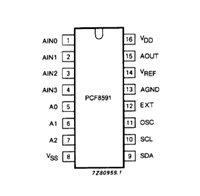AD570
INTERFACING THE AD570 TO A MICROPROCESSOR
The AD570 can easily be arranged to be driven from standard
microprocessor control lines and to present data to any standard
microprocessor bus (4-, 8-, 12- or 16-bit) with a minimum of
additional control components. The configuration shown in
Figure 13 is designed to operate with an 8-bit bus and standard
8080 control signals.
BUS INTERFACING WITH A PERIPHERAL INTERFACE
CIRCUIT
An improved technique for interfacing to a µP bus involves the
use of special peripheral interfacing circuits (or I/O devices),
such as the MC6821 Peripheral Interface Adapter (PIA). Shown
in Figure 14 is a straightforward application of a PIA to multi-
plex up to 10 AD570 circuits. The AD570 has 3-state outputs,
hence the data bit outputs can be paralleled, provided that only
one converter at a time is permitted to be the active state. The
DATA READY output of the AD570 is an open collector with
resistor pull-up, thus several DR lines can be wire-ORed to
allow indication of the status of the selected device. One of the
8-bit ports of the PIA is programmed as an 8-bit input port. The
8-bits of the second port are programmed as outputs, and along
with the 2 control bits (which act as outputs), are used to con-
trol the 10 AD570s. When a control line is in the “1” or high
state, the ADC will be automatically blanked. That is, its out-
puts will be in the inactive open state. If a single control line is
switched low, its ADC will convert and the outputs will auto-
matically go active when the conversion is complete. The result
can then be read from port A. When the next conversion is
desired, a different control line can be switched to zero, blank-
ing the previously active port at the same time. Subsequently,
this second device can be read by the microprocessor, and so-
forth. The status lines are wire-ORed in 2 groups and connected
to the two remaining control pins. This allows a conversion sta-
tus check to be made after a convert command, if necessary.
The ADCs are divided into two groups to minimize the loading
effect of the internal pull-up resistors on the DATA READY
buffers. See the MC6821 data sheet for more application detail.
The input control circuitry shown is required to ensure that the
AD570 receives a sufficiently long B & C input pulse. When the
converter is ready to start a new conversion, the B & C line is
low, and DR is low. To command a conversion, the start ad-
dress decode line goes low, followed by WR. The B & C line
will now go high, followed about 1.5 µs later by DR. This resets
the external flip-flop and brings B & C back to low, which ini-
tiates the conversion cycle. At the end of the conversion cycle,
the DR line goes low, the data outputs will become active with
the new data and the control lines will return to the standby
state. The new data will remain active until a new conversion is
commanded. The self-pulsing nature of this circuit guarantees a
sufficient convert pulse width.
This new data can now be presented to the data bus by en-
abling the three-state buffers when desired. An 8-bit data
word is loaded onto the bus when its decoded address goes
low and the RD line goes low. Polling the converter to deter-
mine if conversion is complete can be done by addressing the
Figure 13. Interfacing AD570 to an 8-Bit Bus
(8080 Control Structure)
gate (shown dotted) which buffers the DR line, if desired. In
this configuration, there is no need for additional buffer register
storage. The data is stored indefinitely in the, since the B & C
line is continually held low.
Figure 14. Multiplexing 10 AD570s Using Single PIA for
µP Interface. No Other Logic Required (6800 Control
Structure)
REV. A
–7–






 STM32F030C6芯片介绍:主要参数分析、引脚配置说明、功耗及封装
STM32F030C6芯片介绍:主要参数分析、引脚配置说明、功耗及封装

 PCF8591数据手册解读:参数、引脚说明
PCF8591数据手册解读:参数、引脚说明

 一文带你了解ss8050参数、引脚配置、应用指南
一文带你了解ss8050参数、引脚配置、应用指南

 深入解析AD7606高性能多通道模数转换器:资料手册参数分析
深入解析AD7606高性能多通道模数转换器:资料手册参数分析
